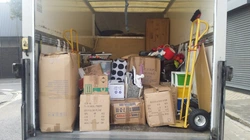Commercial Moves in Office Removals: A Comprehensive Guide

Relocating a business can be a daunting task, especially when it comes to commercial moves in office removals. Whether you're expanding, downsizing, or relocating to a new area, understanding the intricacies of an office move is crucial for minimizing downtime and ensuring a smooth transition.
Office removals involve not just the physical transfer of items but also meticulous planning and coordination. From handling sensitive equipment to ensuring minimal disruption to daily operations, every detail matters.
In this guide, we'll explore the essential aspects of commercial moves, providing you with the knowledge and tools needed to execute a successful office relocation.

Planning Your Commercial Move
Effective planning is the cornerstone of any successful office removal. Begin by establishing a clear timeline that outlines each phase of the move, from initial preparations to the final setup in the new location.
Identify key stakeholders and form a dedicated moving committee to oversee the process. This group should include representatives from different departments to ensure all aspects of the move are covered.
Conduct a thorough inventory of your current office setup. Categorize items based on priority, fragility, and necessity to determine what needs to be moved, stored, or discarded.

Choosing the Right Moving Company
Selecting a professional moving company experienced in commercial office removals is essential. Look for companies with a proven track record, positive reviews, and comprehensive insurance coverage.
Obtain quotes from multiple providers and compare their services, pricing, and timelines. Ensure that the chosen company can handle the specific requirements of your move, such as transporting sensitive electronics or large furniture pieces.
Discuss your specific needs and expectations with the moving company to ensure they can tailor their services accordingly. Clear communication at this stage can prevent misunderstandings and ensure a smoother move.

Packing and Organization
Packing is a critical component of any office removal. Implement a systematic approach by labeling boxes and organizing items by department or function. This will simplify the unpacking process and ensure that everything finds its rightful place in the new office.
Invest in high-quality packing materials to protect your belongings during transit. Use sturdy boxes, bubble wrap, and packing tape to secure items and prevent damage.
Consider hiring professional packers if the volume of items is substantial or if there are delicate items that require careful handling. Professional packers can enhance efficiency and reduce the risk of damage.

Technology and Infrastructure
Ensuring that your office infrastructure is seamlessly transitioned is vital to maintaining productivity. Coordinate with your IT team to plan the disconnection and reconnection of all technological systems.
Backup all critical data before the move to prevent loss during the transition. Schedule the migration of servers and networking equipment to minimize downtime.
Test all systems in the new location prior to the official move-in date to identify and resolve any potential issues. This proactive approach can significantly reduce unexpected disruptions.
Minimizing Downtime
One of the primary concerns during a commercial move is minimizing downtime. Plan the move during off-peak hours or weekends to reduce the impact on daily operations.
Develop a detailed schedule that outlines each step of the move, ensuring that tasks are completed efficiently and on time. Assign specific roles and responsibilities to team members to streamline the process.
Maintain open communication with all employees, keeping them informed about the move timeline and any changes that may affect their work. Transparency can help alleviate stress and maintain morale during the transition.
Post-Move Setup
After the move, focus on setting up the new office environment to ensure a smooth return to normal operations. Prioritize the setup of essential services such as IT systems, telecommunication lines, and office furniture.
Conduct a thorough inspection of the new office space to identify any issues that need immediate attention. Addressing these promptly can prevent disruptions and ensure a comfortable working environment.
Encourage feedback from employees about the new space and be open to making adjustments based on their input. A well-organized and functional office can enhance productivity and employee satisfaction.
Budgeting for Your Move
Budgeting is a critical aspect of any commercial office removal. Develop a comprehensive budget that accounts for all potential expenses, including moving company fees, packing materials, transportation costs, and any additional services required.
Allocate funds for unexpected expenses to avoid financial strain during the move. Regularly review and adjust the budget as needed to stay on track.
Consider cost-saving measures such as donating or selling unused office furniture and equipment. This not only reduces moving expenses but also contributes to sustainability efforts.
Legal and Administrative Considerations
Ensure that all legal and administrative aspects of the move are handled appropriately. Update your business address with relevant authorities, including the post office, banks, and regulatory bodies.
Review and update lease agreements for both your current and new office spaces. Be aware of any termination clauses, renewal options, or fees associated with breaking a lease early.
Maintain records of all moving-related transactions and contracts. Proper documentation can be invaluable in case of disputes or audits.
Environmental Considerations
Incorporating environmentally friendly practices into your office removal can benefit both your business and the planet. Opt for eco-friendly packing materials and recycling programs to reduce waste during the move.
Choose a moving company that prioritizes sustainability, such as those using fuel-efficient vehicles or implementing green practices in their operations.
Implement a paperless approach where possible, reducing the need for excessive printing and minimizing the environmental footprint of your move.
Employee Well-being
Prioritize the well-being of your employees throughout the moving process. Provide clear communication and support to alleviate any concerns or stress associated with the move.
Offer assistance with the relocation process, such as flexible working hours or temporary remote work options during the transition period.
Foster a positive outlook by involving employees in the planning process and encouraging their input on the new office setup. A supportive environment can enhance morale and productivity post-move.
Final Thoughts
Executing a successful commercial move in office removals requires meticulous planning, effective communication, and the right resources. By addressing each aspect of the move with care and attention, businesses can ensure a smooth transition with minimal disruption to operations.
Embrace the opportunity to reorganize and optimize your new office space, creating an environment that fosters growth and productivity for the future.
Ready to make your commercial move seamless and stress-free? Contact us today to learn how our expert team can assist you in achieving a successful office relocation.


